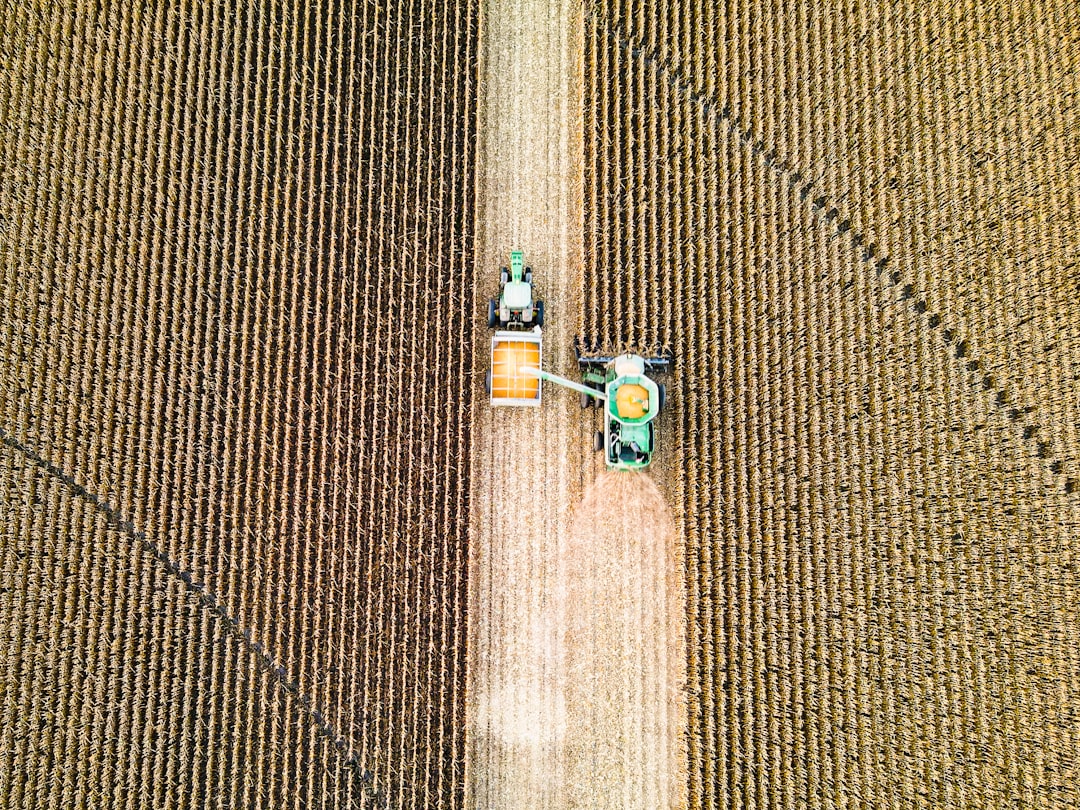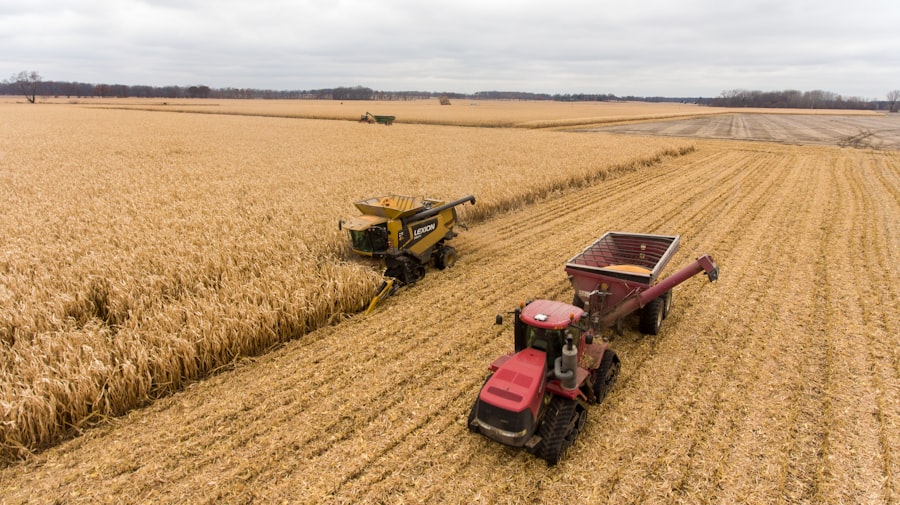Harvesting Corn: When to Pick for Optimal Freshness

Corn is one of the most important crops in agriculture and a staple in many cuisines around the world. It is not only a versatile ingredient that can be used in various dishes, but it also plays a crucial role in the global food supply chain. Understanding the growth cycle of corn, as well as factors that affect its freshness and how to properly harvest and store it, is essential for farmers and consumers alike.
Key Takeaways
- Corn’s growth cycle includes germination, vegetative growth, reproductive growth, and maturity.
- Factors that affect corn’s freshness include temperature, moisture, and exposure to air.
- Corn is ready to harvest when the kernels are plump and the husks are dry and brown.
- Timing is crucial in corn harvesting to ensure maximum flavor and nutrition.
- Tools and techniques for harvesting corn include hand-picking, using a corn picker, or using a combine harvester.
Understanding Corn’s Growth Cycle
Corn goes through several stages of growth before it is ready to be harvested. These stages include germination, vegetative growth, pollination, grain fill, and maturity. Each stage is influenced by various factors such as temperature, soil conditions, and moisture levels.
Germination is the first stage of corn’s growth cycle, where the seed absorbs water and begins to sprout. This stage is highly dependent on soil temperature and moisture. Once the seed has germinated, the plant enters the vegetative growth stage, where it develops leaves and stems. During this stage, corn requires adequate sunlight, water, and nutrients from the soil to grow.
Pollination is a critical stage in corn’s growth cycle as it determines the number of kernels on each ear. Corn is wind-pollinated, meaning that pollen from the tassels at the top of the plant needs to reach the silks on the ears for fertilization to occur. Factors such as temperature and humidity can affect pollination success.
After pollination, the grain fill stage begins, where the kernels on the ears develop and fill with starch. This stage is crucial for determining corn’s yield and quality. Finally, corn reaches maturity when the kernels have reached their maximum size and have dried down. At this point, corn is ready to be harvested.
Factors that Affect Corn’s Freshness
Several factors can affect corn’s freshness after it has been harvested. Moisture content is one of the most critical factors. Corn with high moisture content is more prone to spoilage and can lose its freshness quickly. It is essential to store corn in a cool and dry place to maintain its freshness.
Temperature is another factor that can affect corn’s freshness. Corn should be stored at temperatures between 32°F and 40°F (0°C and 4°C) to slow down the deterioration process. Higher temperatures can accelerate the breakdown of sugars in corn, leading to a loss of flavor and quality.
Proper storage is crucial for maintaining corn’s freshness. It is recommended to store corn in a well-ventilated area to prevent the buildup of moisture, which can lead to mold growth. Additionally, storing corn away from other fruits and vegetables can help prevent the release of ethylene gas, which can accelerate ripening and spoilage.
Identifying When Corn is Ready to Harvest
| Metrics | Description |
|---|---|
| Days to maturity | The number of days from planting to harvest |
| Kernel moisture content | The percentage of water in the corn kernels |
| Kernel milk line | The stage of kernel development where the milk line is visible |
| Ear color | The color of the husks and silks on the ear of corn |
| Starch content | The percentage of starch in the corn kernels |
Knowing when corn is ready to be harvested is essential for ensuring maximum flavor and nutrition. There are several signs that indicate when corn is ripe and ready for harvest. The first sign is the appearance of brown, dry silks on the ears. The silks should be completely dry and easily detach from the ear when gently tugged.
Another sign of ripeness is the color of the husks. Ripe corn husks are usually bright green and tightly wrapped around the ear. As corn matures, the husks may start to turn yellow or brown and become looser.
The final indicator of ripeness is the feel of the kernels. Ripe corn kernels should be plump and firm when pressed with a fingernail. If the kernels are soft or milky, it indicates that the corn is not yet fully matured.
The Importance of Timing in Corn Harvesting
Harvesting corn at the right time is crucial for maximizing flavor and nutrition. If corn is harvested too early, it may lack sweetness and have a starchy taste. On the other hand, if corn is left on the stalk for too long, the sugars in the kernels can convert to starch, resulting in a loss of sweetness.
Timing is also essential for preserving the nutritional value of corn. As corn matures, the nutrient content changes. Harvesting corn at its peak ripeness ensures that it contains the highest levels of vitamins, minerals, and antioxidants.
Tools and Techniques for Harvesting Corn

There are several tools and techniques available for harvesting corn. The most common method is using a combine harvester, which is a machine that cuts and separates the corn kernels from the stalks. This method is efficient and suitable for large-scale farming operations.
For smaller-scale operations or home gardens, hand harvesting is a popular option. Hand harvesting involves manually cutting the ears of corn from the stalks using a sharp knife or shears. This method allows for more control over the harvesting process and is ideal for ensuring maximum freshness and quality.
How to Check Corn for Ripeness
Checking corn for ripeness is essential to ensure that it is harvested at its peak flavor and nutrition. There are several methods to determine if corn is ripe. One method is to peel back a small section of the husk and examine the kernels. Ripe corn kernels should be plump and filled to the tip of the ear.
Another method is to gently press a kernel with your fingernail. If the kernel releases a milky liquid, it indicates that the corn is not yet fully matured. Ripe corn kernels should be firm and not release any liquid when pressed.
Lastly, you can also check the color of the silks. If they are dry and brown, it indicates that pollination has occurred, and the corn is likely ripe.
Tips for Harvesting Corn by Hand
Harvesting corn by hand requires some skill and technique to maximize efficiency and minimize waste. Here are some tips for hand harvesting corn:
1. Start by selecting the ears of corn that are ready for harvest. Look for brown, dry silks and bright green, tightly wrapped husks.
2. Use a sharp knife or shears to cut the ears of corn from the stalks. Make sure to cut close to the base of the ear to avoid leaving behind any stalk or husk.
3. Place the harvested ears of corn in a basket or container lined with a clean cloth or paper towels to prevent bruising and damage.
4. Avoid harvesting more corn than you can consume or store within a short period. Corn is best when consumed fresh, so it is recommended to harvest only what you need.
Best Practices for Storing Freshly Harvested Corn
Proper storage is crucial for maintaining the freshness and quality of freshly harvested corn. Here are some best practices for storing corn:
1. Remove the husks and silks from the ears of corn before storing. This helps prevent moisture buildup and mold growth.
2. Store corn in a cool and dry place, such as a refrigerator or a cool basement. The ideal temperature for storing corn is between 32°F and 40°F (0°C and 4°C).
3. If storing corn in the refrigerator, place it in a plastic bag or wrap it in plastic wrap to prevent moisture loss.
4. Avoid storing corn near fruits and vegetables that release ethylene gas, as it can accelerate ripening and spoilage.
How to Preserve Corn’s Freshness for Longer
If you have harvested more corn than you can consume within a short period, there are several methods available to preserve its freshness for longer:
1. Freezing: Blanch the ears of corn in boiling water for a few minutes, then transfer them to an ice bath to stop the cooking process. Once cooled, remove the kernels from the cob and place them in freezer bags or containers. Frozen corn can be stored for up to 12 months.
2. Canning: Canning involves processing corn in jars with a pressure canner or a water bath canner. This method preserves the corn’s freshness and allows it to be stored for an extended period.
3. Drying: Drying corn involves removing the moisture from the kernels to prevent spoilage. This can be done by air drying or using a food dehydrator. Dried corn can be stored in airtight containers for several months.
Harvesting Corn for Maximum Flavor and Nutrition
To harvest corn for maximum flavor and nutrition, consider the following factors:
1. Timing: Harvest corn when the silks are dry and brown, the husks are bright green, and the kernels are plump and firm. This ensures that the corn is at its peak ripeness and contains the highest levels of flavor and nutrients.
2. Storage: Properly store freshly harvested corn in a cool and dry place to maintain its freshness. Avoid storing corn for too long, as it can lose its flavor and nutritional value over time.
3. Handling: Handle corn with care to prevent bruising and damage. Avoid dropping or throwing ears of corn, as it can lead to loss of quality.
4. Consumption: Consume freshly harvested corn as soon as possible to enjoy its maximum flavor and nutritional benefits. If preserving corn for longer, choose methods that retain its freshness and quality.
Properly harvesting and storing corn is essential for maintaining its freshness, flavor, and nutritional value. Understanding the growth cycle of corn, identifying signs of ripeness, and using appropriate tools and techniques are crucial for successful harvesting. Additionally, proper storage methods and preservation techniques can help extend the shelf life of freshly harvested corn. By following these best practices, farmers and consumers can enjoy the full benefits of this versatile and nutritious crop.
If you’re wondering when is the best time to pick corn, you might find this article on Lawn World’s website helpful. It provides valuable insights and tips on determining the right moment to harvest your corn crop. From understanding the signs of ripeness to checking the kernels’ texture, this article covers it all. To learn more about picking corn at its peak, check out this informative resource on Lawn World’s website: https://www.lawnworld.com/sitemap.html.
FAQs
What is the best time to pick corn?
The best time to pick corn is when the kernels are plump and milky, and the husks are green and tightly wrapped around the ear.
How do I know if the corn is ready to be picked?
You can tell if the corn is ready to be picked by gently pulling back the husk and checking the kernels. If they are plump and milky, the corn is ready to be harvested.
What happens if I wait too long to pick the corn?
If you wait too long to pick the corn, the kernels will become tough and starchy, and the flavor will be less sweet and more bland.
Can I pick corn before it is fully mature?
It is not recommended to pick corn before it is fully mature, as the kernels will not be fully developed and the flavor will not be as sweet.
How do I store freshly picked corn?
Freshly picked corn should be stored in the refrigerator, with the husks still intact, for up to 5 days. If you want to store it for longer, you can blanch and freeze the corn.



